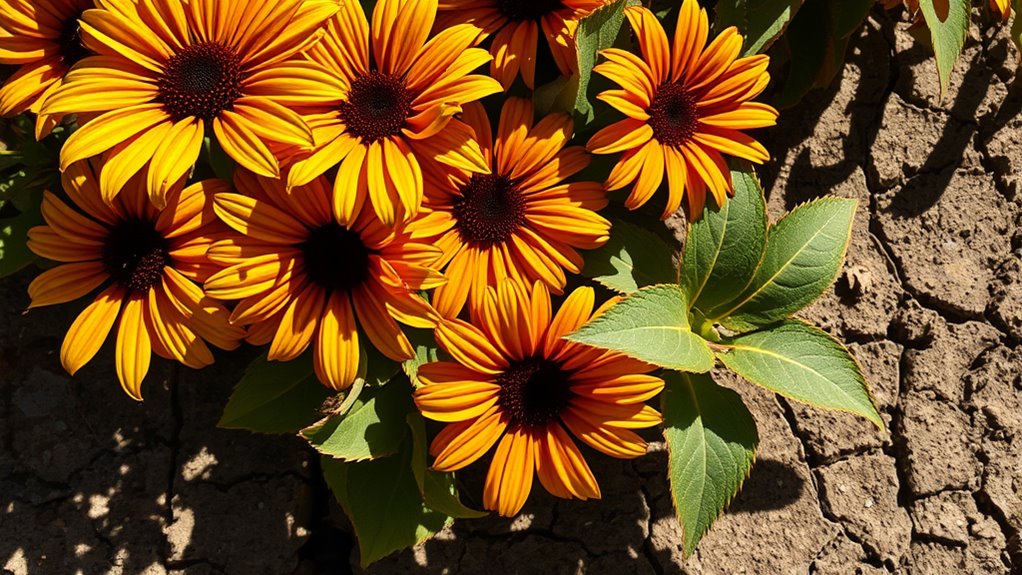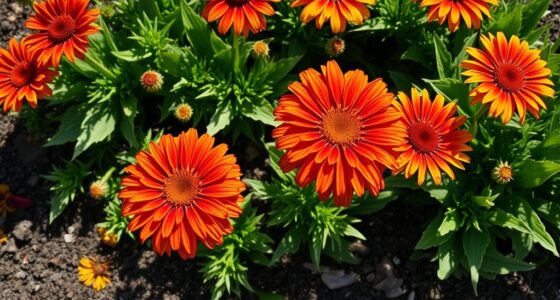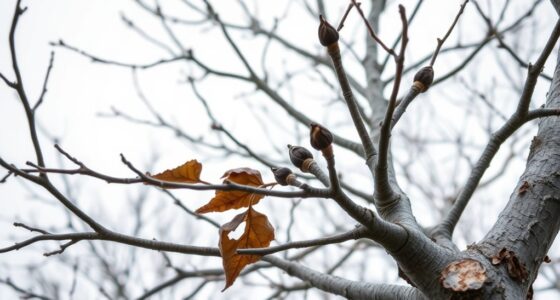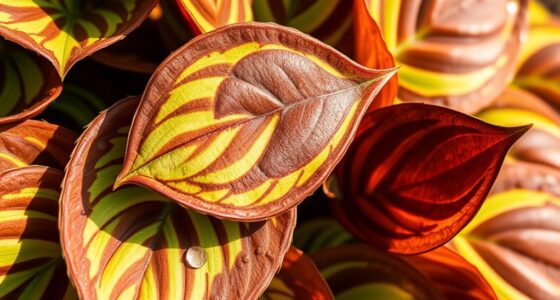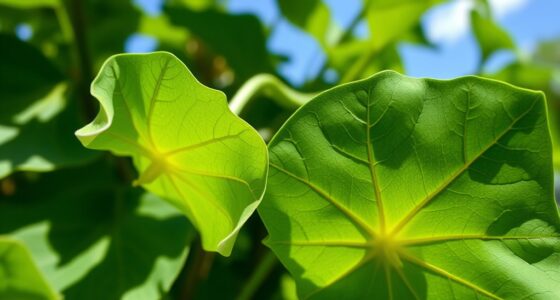Your gazanias may be dying because they’re not getting the right amount of sun, with too much or too little causing stress. Poor soil drainage or nutrient deficiencies can also weaken them, while pests like aphids or spider mites may damage leaves and roots. Overwatering or fungal diseases further harm the plants. If you want to identify and fix these issues effectively, knowing the signs and proper care steps will help guarantee healthier gazanias to thrive.
Key Takeaways
- Ensure gazanias receive at least 6 hours of direct sunlight daily; adjust placement if leaves show scorch or legginess.
- Use well-draining soil with organic amendments to prevent root rot and address nutrient deficiencies.
- Regularly inspect plants for pests like aphids, spider mites, and whiteflies, and treat infestations early.
- Water deeply but infrequently, allowing soil to dry between watering to avoid fungal diseases.
- Remove diseased leaves promptly, maintain proper airflow, and disinfect tools to prevent disease spread.
Assessing Sunlight Requirements for Gazanias
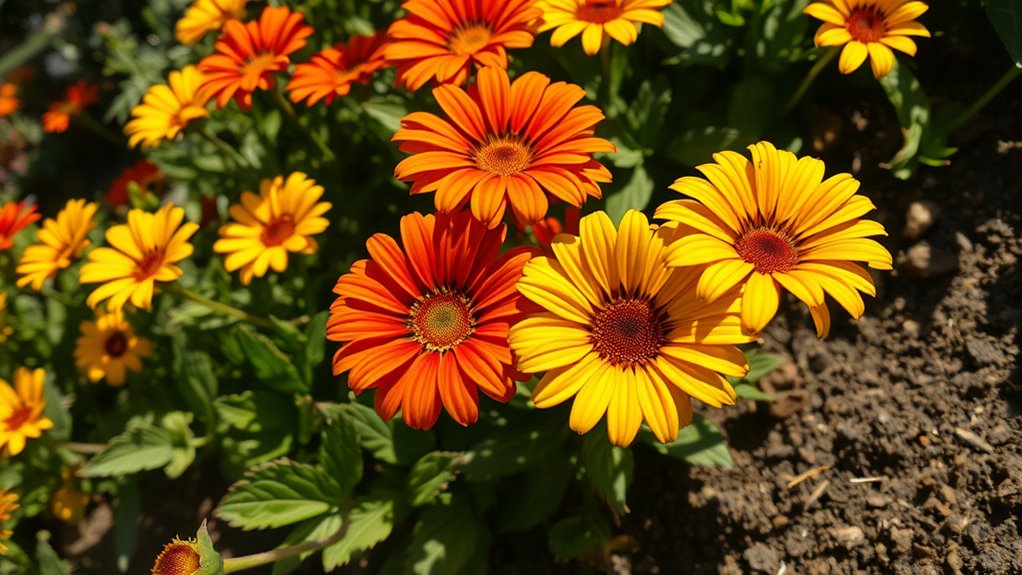
Gazanias thrive best when they receive plenty of sunlight, making it essential to assess their specific light needs. Ensure your gazanias get at least six hours of direct sun daily for vibrant blooms and healthy growth. Proper gazanias watering is vital; avoid overwatering, which can lead to root rot, and water only when the topsoil feels dry. Consistent watering encourages strong, resilient plants. Additionally, pruning plays a crucial role in maintaining sunlight exposure; regularly remove dead or faded flowers and trim leggy growth to promote bushier, more vigorous plants. Monitoring sunlight requirements and adjusting watering habits are key to success. Practicing timely gazanias pruning and ensuring adequate light will foster a thriving, colorful garden with healthy, resilient gazanias. To optimize plant health, understanding plant care fundamentals can help you address other common issues that may affect your gazanias. Recognizing signs of nutrient deficiencies can further enhance their vitality and overall appearance.
Identifying Signs of Overexposure or Insufficient Sunlight
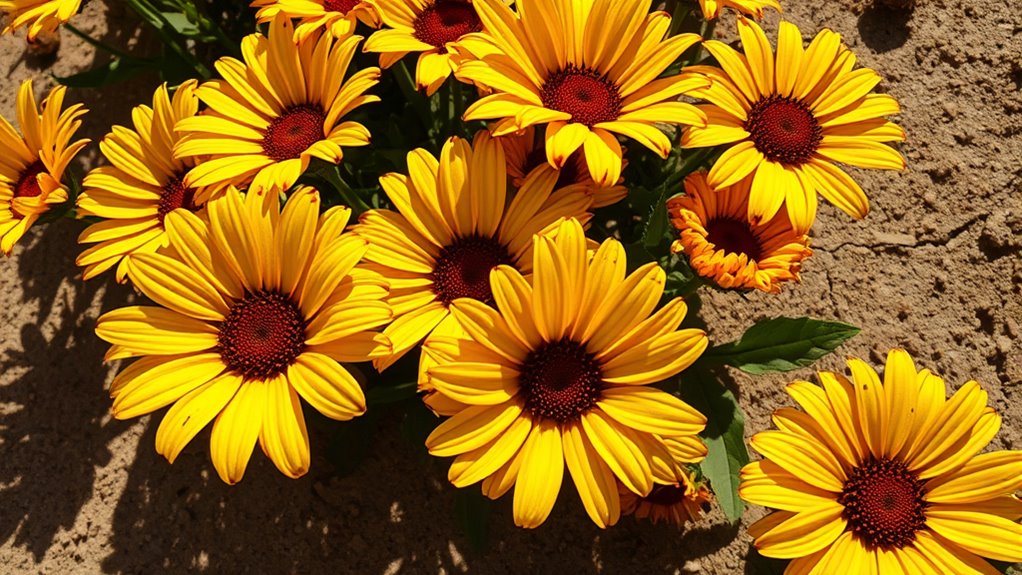
Monitoring the sunlight your gazanias receive helps guarantee they stay healthy and vibrant. Too much direct sun can cause leaf scorch, where edges turn brown, and the plants may look bleached or faded. This indicates overexposure and a disrupted sunlight balance. On the other hand, insufficient sunlight leads to legginess, with elongated stems and sparse blooms, as gazanias struggle with their shade tolerance. If your plants are stretching toward the light or producing fewer flowers, they might not be getting enough sun. Pay attention to these signs to adjust their placement accordingly. Ensuring they receive the right amount of sunlight will help maintain their health, color, and overall importance. Remember, understanding their sunlight needs is key to thriving gazanias. Proper light management can significantly improve their growth and vibrancy.
Analyzing Soil Drainage and Composition
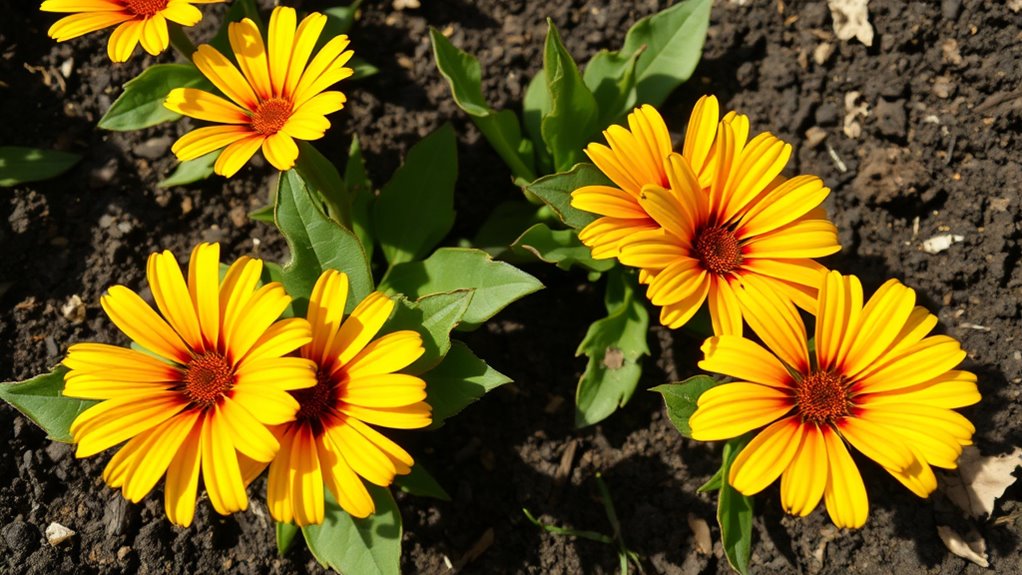
To make certain your gazania thrives, it’s vital to analyze the soil’s drainage and composition. Good soil aeration allows roots to breathe and prevents waterlogging, which can cause root rot. Check if water drains quickly after watering; slow drainage indicates compacted soil. If drainage is poor, consider adding organic amendments like compost or perlite to improve aeration and structure. These amendments enhance soil texture, balancing moisture retention with drainage. Avoid heavy, clay-rich soils that retain excessive water, as gazanias prefer well-draining soil. Regularly testing your soil helps you identify its composition and make necessary adjustments. Incorporating soil testing can help you better understand your soil’s needs and prevent potential issues. Using sulfate-free products can help reduce unnecessary stress on your plants and maintain healthy soil conditions. Additionally, understanding the soil health of your garden can promote overall plant vitality and prevent problems before they arise. By optimizing drainage and enriching the soil with organic amendments, you’ll create a healthy environment for your gazanias to flourish.
Recognizing Symptoms of Poor Soil Quality or Nutrient Deficiency
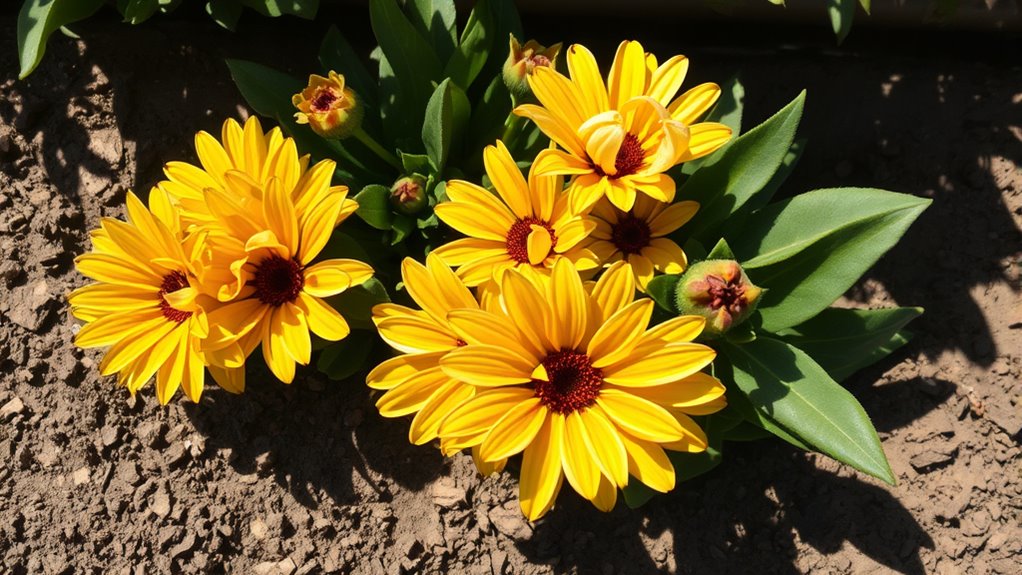
You may notice your gazania’s leaves turning yellow or pale, which can signal nutrient deficiencies. Soil testing can reveal low levels of essential nutrients or imbalances that affect plant health. Recognizing these signs early helps you address soil issues before they harm your plants further. Additionally, understanding soil quality factors can guide you in making informed amendments to improve your garden’s overall health. Improving soil drainage can also prevent root rot and other issues caused by overly wet soil, and maintaining proper soil nutrient levels supports healthy plant growth.
Nutrient Deficiency Signs
Recognizing nutrient deficiency signs in gazania plants is essential for maintaining healthy blooms and vibrant foliage. When plants lack essential nutrients, they show specific symptoms that indicate poor soil quality. You might notice yellowing leaves, stunted growth, or pale flowers. These signs often point to deficiencies in nitrogen, potassium, or magnesium. Proper fertilizer application can correct these issues, ensuring your gazanias thrive. Additionally, mulch benefits include conserving moisture and slowly releasing nutrients, helping prevent deficiencies. Keep an eye on the following signs:
| Symptom | Possible Deficiency | Action |
|---|---|---|
| Yellowing leaves | Nitrogen | Apply balanced fertilizer |
| Browning leaf edges | Potassium | Use potassium-rich fertilizer |
| Pale flowers | Magnesium | Add magnesium supplement |
| Stunted growth | General nutrient deficiency | Improve soil nutrients |
Soil Testing Indicators
Soil testing indicators provide clear signs that your gazania’s soil may be poor or lacking essential nutrients. If your plant shows stunted growth, yellowing leaves, or poor flowering, it’s time to check the soil’s health. During soil testing, look for low levels of nitrogen, phosphorus, or potassium, which are vital for healthy growth. Soil that feels compacted or drains poorly may signal issues with soil structure, affecting root development. You might notice a lack of vibrant color or weak stems, indicating nutrient deficiencies. To improve soil quality, consider adding soil amendments like compost or organic matter, which can boost nutrient levels and enhance drainage. Regular soil testing helps you identify problems early, so you can take targeted action to support your gazania’s health. Incorporating soil analysis technology can further streamline the detection of soil issues and optimize your gardening efforts.
Detecting Common Pests That Affect Gazanias
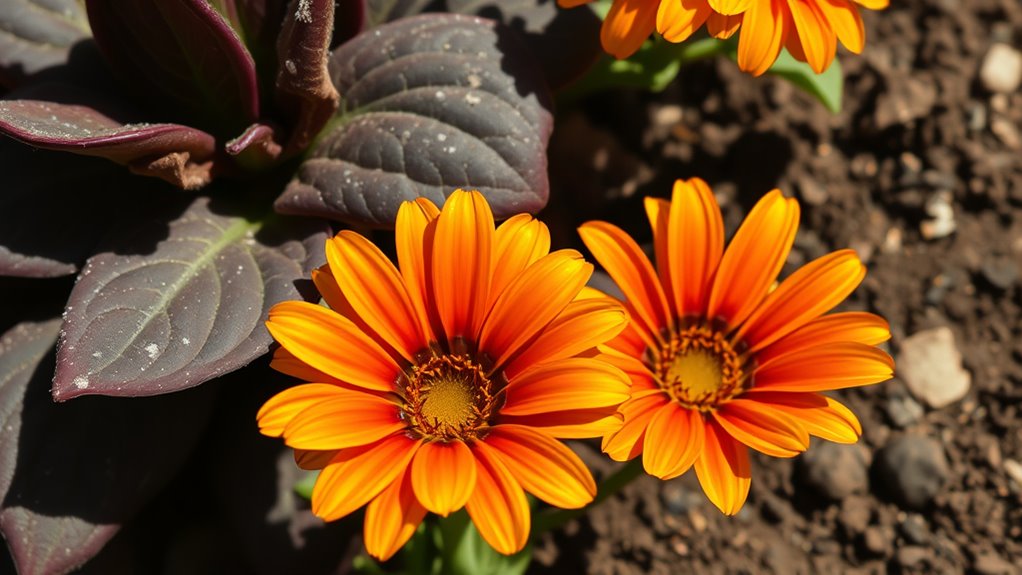
While gazanias are generally hardy plants, they can fall prey to several common pests that quickly diminish their vibrant appearance. To catch problems early, focus on pest identification by inspecting leaves and stems regularly. Look for telltale signs like tiny holes, sticky residue, webbing, or discolored patches. Common pests include aphids, spider mites, and whiteflies. Recognizing these pests early helps you take swift action. Pest prevention starts with maintaining healthy plants—avoid overwatering, ensure proper spacing, and remove debris where pests hide. Using natural predators or organic sprays can also help keep pests at bay. Regular monitoring and proactive care are your best defenses against pests, ensuring your gazanias stay healthy and colorful all season long. Incorporating beneficial ingredients like neem oil or introducing predator insects can further enhance your pest management strategy. Additionally, understanding the best application techniques for these solutions ensures maximum effectiveness.
Examining for Signs of Pest Infestation or Damage

Regularly examining your gazanias for signs of pest infestation or damage helps catch problems early before they spread. Look for leaf discoloration, holes, or sticky residue, which indicate pests. Check the roots for damage, such as softness or discoloration, which can signal root rot or pest activity underground. Use the table below to guide your inspection:
| Symptom | Possible Cause | Action Needed |
|---|---|---|
| Leaf discoloration | Pests or nutrient deficiency | Remove pests, adjust fertilization |
| Root damage | Root rot or underground pests | Improve drainage, treat soil |
| Damaged leaves or holes | Insect feeding | Apply appropriate pest control |
Additionally, employing vetted textile line techniques can improve your plant protection methods. Regular monitoring and early intervention are key to maintaining healthy gazanias, especially when integrating effective pest management strategies. Incorporating proper soil care can also prevent many underground issues and promote healthy growth.
Understanding Watering Practices and Their Impact
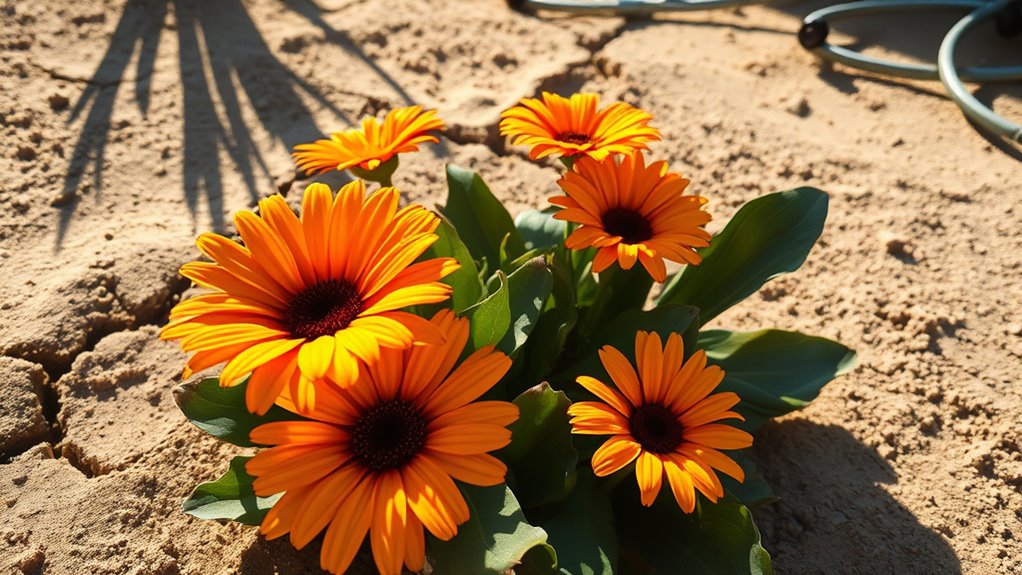
Proper watering is essential for healthy gazanias, as both overwatering and underwatering can cause stress and damage. You should pay attention to your plant’s watering frequency, ensuring you don’t water too often or too little. Gazanias prefer well-drained soil, so check moisture levels regularly to prevent sogginess or dryness. If the soil feels consistently wet, reduce watering; if it’s dry several inches down, increase it. Water deeply, but infrequently, allowing the soil to dry out between sessions. Consistent moisture levels help prevent root rot and promote vigorous growth. Remember, environmental factors like temperature and rainfall influence watering needs, so adjust accordingly. Proper watering practices keep your gazanias vibrant and healthy, reducing the risk of stress-related issues. Additionally, understanding watering practices can help optimize plant health and prevent common problems associated with improper watering.
Troubleshooting Disease and Fungal Issues
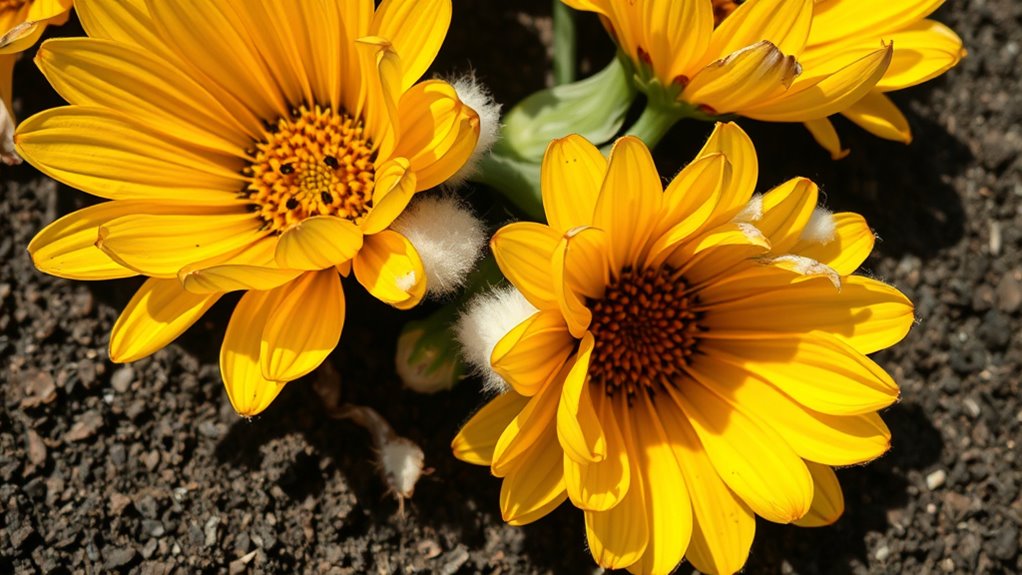
When your gazania shows wilting, spots, or fuzzy growth, you’re likely facing fungal problems. To keep these issues at bay, identify symptoms early and take steps to prevent soil infections. Managing disease spread quickly helps protect the health of your entire plant.
Identifying Common Fungal Symptoms
Fungal infections in gazania often reveal themselves through specific visual signs that you can learn to recognize. Look for discolored, wilting, or spotted leaves, which indicate possible fungal issues. You might notice fuzzy or powdery growth on foliage, especially during humid conditions. To manage these symptoms, use proper pruning techniques to remove infected plant parts, preventing the spread of fungi. Applying mulch can also help by improving soil drainage and reducing soil splashes that carry fungal spores onto leaves. Keep an eye out for soft, rotting stems or spots that expand rapidly. Early identification of these symptoms allows you to act swiftly, reducing damage and protecting your gazanias from more severe fungal infections. Additionally, understanding plant health fundamentals can help you implement preventative measures to keep your gazanias thriving.
Preventing Soil-borne Infections
To prevent soil-borne infections in your gazania, you need to focus on maintaining healthy soil conditions and practicing good sanitation. Start by enriching your soil with appropriate soil amendments that improve drainage and reduce pathogen buildup. Avoid overwatering, which can create a damp environment perfect for fungal growth. Choose pest-resistant varieties, as they tend to be less susceptible to soil-borne diseases linked to pests. Remove any plant debris or infected plant material promptly, and disinfect gardening tools regularly to prevent spreading pathogens. Avoid planting gazanias in areas with a history of fungal issues, and consider rotating crops to break disease cycles. These steps help create an environment where your gazanias can thrive without the threat of soil-borne infections.
Managing Disease Spread Effectively
Effectively managing disease spread in your gazania involves quick identification and prompt action. To prevent fungi and bacterial issues from spreading, start by inspecting your plants regularly. Use these steps:
- Remove infected leaves immediately using proper pruning techniques to contain the disease.
- Space your gazanias appropriately to improve airflow, reducing humidity that fosters fungal growth.
- Practice companion planting with herbs like rosemary or marigolds, which can repel pests and reduce disease risk.
- Sterilize pruning tools after each use to avoid cross-contamination.
Implementing Proper Care and Maintenance Strategies

Implementing proper care and maintenance strategies for gazania guarantees healthy growth and vibrant blooms. Start with container gardening to control soil quality and drainage, ensuring your gazanias thrive. Use mulching techniques to conserve moisture, suppress weeds, and regulate soil temperature. Regular watering is essential but avoid overwatering to prevent root rot. Fertilize lightly during the growing season for ideal blooms. Prune dead or faded flowers to encourage new growth. Here’s a quick guide:
| Care Step | Action | Benefit |
|---|---|---|
| Container Gardening | Use well-draining soil in pots | Improves drainage and control |
| Mulching Techniques | Apply organic mulch around plants | Maintains moisture, prevents weeds |
| Regular Maintenance | Remove dead foliage, prune regularly | Promotes healthy growth |
Frequently Asked Questions
Can Temperature Fluctuations Affect Gazania Health?
Temperature fluctuations can definitely impact your gazanias’ health. Sudden seasonal changes and temperature stress may cause stress to the plants, leading to wilting or poor growth. Gazanias thrive in warm, stable conditions, so extreme cold or heat can weaken them. To keep your plants happy, make certain they’re protected from drastic temperature shifts, especially during seasonal changes, and provide some shade during intense heat to prevent damage.
How Often Should I Fertilize Gazanias for Optimal Growth?
You should fertilize your gazanias every 4 to 6 weeks during the growing season to maintain a proper fertilizer schedule. Use a balanced, water-soluble fertilizer to guarantee the nutrient balance stays ideal. Avoid over-fertilizing, as this can cause excessive foliage growth at the expense of flowers. Regular feeding helps keep your gazanias healthy, vibrant, and blooming throughout the season.
Are There Specific Watering Techniques to Prevent Root Rot?
To prevent root rot, you should follow a proper watering schedule that keeps soil moist but not soggy. Water deeply but infrequently, allowing the soil to dry out between watering sessions. Additionally, improve drainage by adding organic matter or gravel if needed, ensuring excess water doesn’t accumulate around the roots. This approach helps maintain healthy roots and prevents the conditions that lead to root rot.
What Are Natural Remedies for Pest Infestations?
Pest infestations can creep up like unwelcome guests. You can fight back with natural remedies by using organic pest control methods, such as introducing beneficial insects or homemade sprays. Companion planting also acts as a shield, repelling pests naturally. These eco-friendly strategies help protect your gazanias without chemicals, keeping your garden healthy and vibrant. Embrace nature’s own toolkit for a pest-free paradise.
How Do I Distinguish Between Disease Symptoms and Pest Damage?
To distinguish between disease symptoms and pest damage, you need to observe the signs closely. Disease identification often shows as spots, mold, or wilting, while pest symptoms include holes, chewed leaves, or visible insects. Check for consistent patterns—diseases usually spread uniformly, whereas pests may be localized. By carefully examining your plants, you can better identify whether pests or diseases are causing the damage and take appropriate action.
Conclusion
If your Gazanias are still struggling, consider the popular theory that their health depends solely on sunlight. While sunlight is essential, neglecting soil quality, pests, and watering can also cause decline. By balancing sun exposure, ensuring well-draining soil, checking for pests, and watering correctly, you give your Gazanias the best chance to thrive. Remember, a holistic approach often proves more effective than focusing on just one factor.
